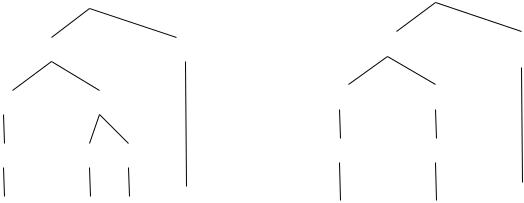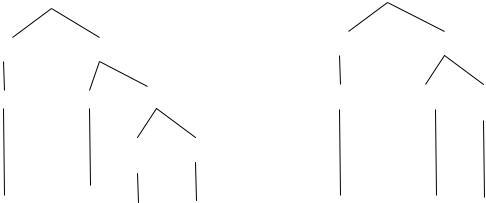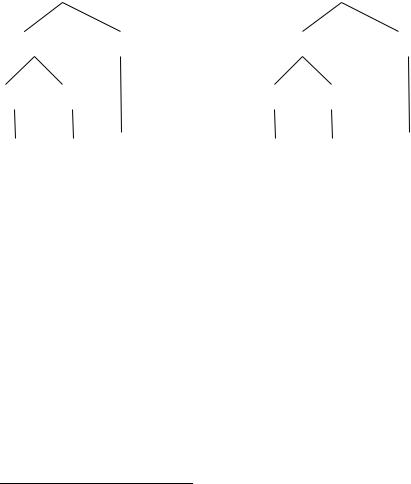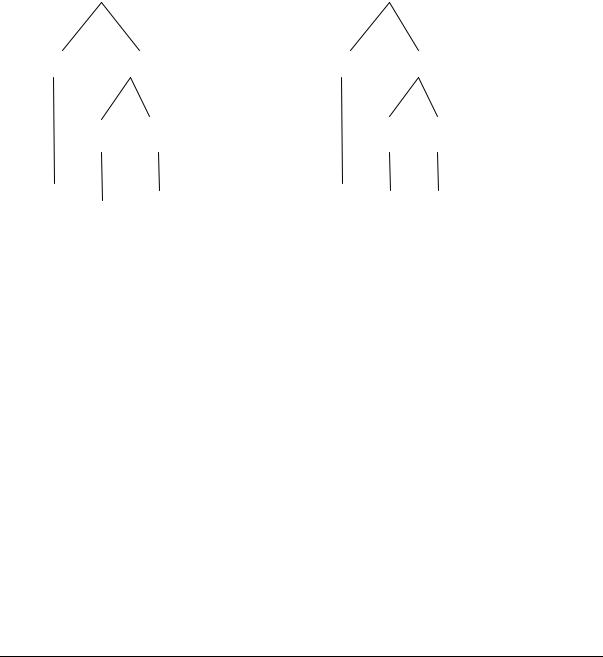
boudlal_abdelaziz_the_prosody_and_morphology_of_a_moroccan_a
.pdf
attaches, is defined in morphological terms. The morphological structures of the compound forms in 29 are given in 35 below:
-35-
a. word[[[nas]stem]word-[əl-[γiwan]stem]word]word
word[[[wlad]stem]word-[[ħriz]stem]word]word
word[[[bni]stem]word-[[məllal]stem]word]word word[[[bni]stem]word-[[zərwal]stem]word]word
b. word[[D[DaR]stem]word-[əl-[biDa]stem]word]word word[[[qəlʕət]stem]word-[əs-[sraγna]stem]word]word word[[[wlad]stem]word-[[ʕəbbu]stem]word]word word[[[wlad]stem]word-[[ħəddu]stem]word]word
In the case of the compounds, the nisba morpheme has to attach to a base which should not have a morphologically complex shape. More specifically, it has to attach to the rightmost stem of the base. The input to the nisba cannot be the rightmost stem alone but it is the rightmost stem part of the whole compound word. In other words, nisba forms such as [γiwani] and [ħrizi] are derived not from the stems [γiwan] and [ħriz] but from the compound words [nasəlγiwan] and [wladəħriz], respectively. Thus nisba adjectives such as *[nasəlγiwani] and *[wladəħrizi] are failed candidates not because they consist of more than three syllables but because the nisba morpheme has been attached to the category ‘word’ and not to the category ‘stem’. Within the theory of word syntax (Selkirk 1982), the structures of *[nasəlγiwani] and *[wladəħrizi] are shown in 36:
179

-36- |
|
|
|
|
|
a. *Word |
|
b. *Word |
|
||
Word |
|
Aff |
Word |
|
Aff |
word |
word |
|
word |
word |
|
stem |
Aff |
stem |
stem |
stem |
|
nas |
l |
γiwan i |
wlad |
ħriz |
i |
The question we will try to answer below relates to the nature of the constraint(s) ruling out structures where the nisba affix is sister to the category ‘word’ instead of the category ‘stem’.
In order to exclude structures like the ones in 36, we could possibly posit, following McCarthy (1993b), an alignment constraint of the type ALIGN (Nisba, L, Rightmost Stem, R) requiring that the left edge of the nisba morpheme coincide with the right edge of the rightmost stem. However, the problem with alignment constraints is that they do not say anything about hierarchical morphological structural relations since these constraints govern the relation of terminal strings. Therefore, and in order to account for the case of affixation to stem observed in the nisba adjectives derived from compounds, we need to invoke a specific class of constraints, which we call affixation constraints. These constraints account for the place of affixes in the hierarchical morphological structure, i.e. they specify the morphological category to which a particular affix attaches. In the case of the CMA nisba adjectives, the affixational constraint needed is stated in 37 below:
-37-
AFFIX (Nisba, R, NOUNstem, R) ( henceforth AFFIX-TO-Nstem)
The nisba morpheme is suffixed to a noun stem.
Following Selkirk (1982), satisfying this constraint will give a derived structure where a stem dominates the nisba suffix and the noun stem. An additional principle from Selkirk calls for the projection of the features associated with the head of a morphological constituent. Since the nisba is an adjective-creating suffix in that it changes the syntactic category of the base to
180

which it attaches, we assume that this suffix is specified as [+adjective] and that, being the head, it projects its adjectival feature, thus producing an adjectival stem as the dominating node. In addition to the feature [+adjective], the nisba suffix projects other features such as [- feminine] and [-plural] since the resulting word is always masculine singular. Given the affixation constraint in 37 and the projection of the adjectival feature of the nisba, the structures in 36 will look like the ones in 38 below. (Noun and Adj stand for the major lexical category corresponding to ‘word’, Naff stands for ‘noun affix’ and Adjaff stands for ‘adjectival affix’)
-38- |
|
|
|
|
|
|
a. |
?? |
|
|
b. |
?? |
|
Noun |
Adj |
|
|
Noun |
Adj |
|
Nstem |
Naff |
Adj |
|
Nstem |
Nstem |
Adjaff |
|
|
Nstem |
Adjaff |
|
|
|
nas |
l |
γiwan |
i |
wlad |
ħriz |
i |
As to the syntactic category of the whole compound, it is yet to be determined. It will be shown below that whenever a situation such as the one in 38 arises, the leftmost member of the compound is truncated. Truncation of this type could be understood if we know that the only compound structure allowed in CMA is one where both members are nouns.
Given that the compound nouns in 35 consist of two noun stems, attaching the nisba morpheme to the leftmost or to the rightmost stem would satisfy the constraint AFFIX-TO- Nstem. If this is the case, how is it possible to exclude forms such as *[nasilγiwan] and *[wladiħriz], where the nisba morpheme (written in bold) attaches to the leftmost stem and
181

retain forms such as those in 38, where the nisba attaches to the rightmost stem?6
The answer to this question comes from the Generalized Alignment Theory of McCarthy and Prince (1993b), and more particularly from a constraint requiring right alignment of the nisba affix and the PWd. This constraint is stated in 39 below:
-39-
ALIGN (Nisba, R, PWd, R) (henceforth ALIGN-Nisba-R)
The right edge of the nisba affix must be aligned with the right edge of the PWd.
This constraint, if satisfied, rules out any output form where the nisba is attached to the leftmost noun stem, a fact which shows that ALIGN-Nisba-R has to dominate AFFIX-TO-Nstem.
In compound nouns, suffixation of the nisba morpheme to the stem causes truncation of part of the base, i.e. any segment occurring to the left of the rightmost stem of the compound. In other words, the definite article (if any) and the leftmost member of the compound, which happens to be the head (Al Ghadi 1990, Boudlal 1993), are deleted, thus causing violation of the constraint Morpheme Realization (Samek-Lodovici 1993, Rose 1997, Gnanadesikan 1997) which is stated as follows:
-40-
Morpheme Realization (henceforth MORPH-REAL)
An input morpheme must be realized in the output.
In order to get the truncation of any morpheme occurring to the left of the rightmost stem, we need a constraint of the type in 41 below, ruling out compound constructions that consist of a noun and a nisba adjective.
6 Further support for choosing the rightmost stem of a compound as a base for the nisba comes from abbreviated names whose leftmost stem, which is consistently the stem [ʕəbd] “servant of”, is truncated as shown in the following items:
ʕəbd-lə-ʕziz ʕaziz ʕəbd-lə-krim karim ʕəbd-əl-ħakim ħakim
The rightmost adjectival noun which is retained is subject to a constraint requiring that it be disyllabic, a fact which shows why stems such as [ʕaziz] and [ħakim] proceed to augmentation by a-affixation.
182
-41-
*[Noun + Adjective]PWd (henceforth *[N + A]PWd)
A sequence of a noun and an adjective is prohibited.
If this constraint together with the constraints ALIGN-Nisba-R and AFFIX-TO-Nstem dominates MORPH-REAL, the morpheme(s) occurring to the left of the rightmost stem will not be realized. In 42 below, we shown how the nisba adjective [γiwani], derived from the base noun [nasəlγiwan] wins over other competing candidates. We assume that violation of MORPH-REAL is categorical, i.e. a form incurs a single violation even if more than one morpheme is deleted:
-42-
word[[[nas]stem]word-[əl-[γiwan]stem]word]word -i |
*[N + A]PWd |
ALIGN- |
AFFIX- |
MORPH- |
|
|
Nisba-R |
TO-Nstem |
REAL |
|
|
|
|
|
|
|
|
|
|
)a. γiwani |
|
|
|
* |
|
|
|
|
|
b. nasəlγiwani |
*! |
|
* |
|
|
|
|
|
|
c. nasilγiwan |
|
*! |
|
|
|
|
|
|
|
d. nasi |
|
*! |
|
* |
|
|
|
|
|
In the optimal candidate, the right edge of the nisba suffix is aligned with the right edge of the PWd, which happens to be the base. The failure of the definite article and the leftmost stem of the compound to be realized in 42a is dictated by the constraint banning structures where the PWd contains compound structures that consist of a noun and an adjective. Such is not the case with candidate 42b which is ruled out because of violating higher-ranked *[N + A]PWd. One way of avoiding a sequence of a noun and an adjective and therefore violation of the constraint *[N + A]PWd is for the nisba morpheme, held responsible for projecting its adjectival feature to the mother node dominating this morpheme and the noun stem, to attach to the leftmost stem of the compound. This is exactly the case with candidate 42c which satisfies *[N + A]PWd but fails because the right edge of the nisba suffix does not correspond to the right edge of the PWd. The same thing could be said about candidate 42d, except that it incurs, in addition to *[N + A]PWd, a gratuitous violation of MORPH-REAL.
183
Next, consider an input such as [DDaRəlbiDa] (from the list in 35b) where the base ends up in a vowel. Since the nisba suffix is a vowel, we should expect glide epenthesis to apply to provide an onset to the syllable whose nucleus is the suffix vowel. This is exactly what happens. The optimal candidate [biDawi] incurs a violation of the lower-ranked DEP-IO by epenthesizing the glide [w] and this in order to satisfy the undominated constraint ONSET. It also incurs a violation of another lower-ranked constraint, namely MORPH-REAL, by deleting the definite article and the leftmost stem of the compound in order to satisfy the constraint *[N + Adj]PWd. A candidate such as *[biDai] is excluded on the ground that it incurs a fatal violation of ONSET. Finally, other forms such as *[DDaRilbiDa] and *[DDaRəlbiDawi] are failed candidates because of different reasons. *[DDaRilbiDa] fails because the nisba morpheme is adjoined to the leftmost stem of the base compound, thus causing a fatal violation of ALIGN-Nisba-R, whereas *[DDaRəlbiDawi] fails because it consists of a sequence of a noun and an adjective which is ruled out by the constraint *[N + Adj]PWd.
Morphologically conditioned truncation is not restricted to compound constructions; it also applies in certain toponyms containing the discontinuous feminine affix [ta-…-t] and the prefix [(ʔ)a-] as the examples in 43 for illustration:
-43- |
|
|
|
|
Base |
Nisba |
Gloss |
a. |
tafilalt |
filali |
from Tafilalt |
|
tarudant |
rudani |
from Taroudant |
|
taħənnawt |
ħənnawi |
from Tahannaout |
|
taməSluħt |
məSluħi |
from Tameslouht |
b. |
ʔazəmmur |
zəmmuri |
from Azemmour |
|
ʔasfi |
sfiwi/məsfiwi |
from Safi |
|
ʔaməzzru |
məzzriwi |
from Amezrou |
The suffixation of the nisba morpheme results in the deletion of the discontinuous morpheme [ta-...-t] and the prefix [(ʔ)a-]. The two affixes are of Berber origin: [(ʔ)a-] marks the singular
184

number, and [ta-...-t] shows that the word is feminine singular7.What is more important for us here is that the nisba morpheme adjoins to a noun stem rather than to the major lexical category noun, corresponding to the ‘word’. Adjoining the nisba morpheme to the ‘word’ would result in ungrammatical forms exemplified by the words *[tafilalti] and *[ʔazəmmuri] whose internal hierarchical morphological structures we give in 44 below:
-44- |
|
|
|
|
a. * Word |
b. |
* Word |
|
|
word |
Aff |
word |
Aff |
|
Aff |
stem |
Aff |
Stem |
|
ta-...-t |
rudan i |
ʔa |
zəmmur |
i |
In the structure in 44a, the discontinuous affix [ta-...-t] could well appear to the right of the stem and the result would always be the same. It is the sister node that determines the morphological category to which the nisba affix is attached. In both structures, the nisba morpheme is sister to the category ‘word’, a state of affairs which is ruled out by the constraint AFFIX-TO-Nstem. It has already been established above that ALIGN-Nisba-R must dominate AFFIX-TO-Nstem to ensure that the nisba morpheme appears at the right edge of the base in the case of compounds. With simple words such as those in 43, attaching the nisba morpheme to a noun stem would lead to the violation of ALIGN-Nisba-R, especially in bases with the discontinuous morpheme [ta-...-t] (cf. words such as *[tarudanit] and *[tafilalit], where the nisba is placed before the second part of the discontinuous morpheme). This points out to the fact that another constraint must dominate ALIGN-Nisba-R. In the case of the nisba
7 The same morpheme is used in MA to derive abstract nouns of profession such as the following:
Base Noun |
N. of Profession |
Base Gloss |
bənnay |
tabənnayt |
mason |
fəllaħ |
tafəllaħt |
farmer |
ħəddad |
taħəddatt |
blacksmith |
ʃəffar |
taʃəffart |
thief |
Here the discontinuous morpheme [ta-...-t] has both a derivational and an inflectional status. It performs more than the function it has in Berber which is marking the word for the feminine gender.
185

with compounds, it has been shown that it is the constraint *[N + Adj]PWd which forces the deletion of the leftmost member of the compound. In the case of the nisba with bases containing the affixes [ta-...-t] and [ʔa-], adjoining the nisba morpheme to the noun stem produces an adjectival stem as the dominating node, thus creating a sequence of a noun and an adjective as shown in 45:
-45- |
|
|
|
a. |
?? |
b. |
?? |
Naff |
Adj |
Naff |
Adj |
Nstem Adjaff |
Nstem Adjaff |
ta-...-t |
rudan i |
ʔa zəmmur i |
The structures in 45 are reminiscent of a situation which is déjà vu with the compounds in 38 above. Both the structures in 45 and the structures in 38 contain a sequence of a noun and an adjective. The only difference is that the noun in 38 does not correspond to a major lexical category; it is an affix which is specified as [+noun]. The juxtaposition of a noun (or a nominal affix) and an adjective makes it impossible to determine which of the two categories the mother node, dominating both the nominal affix and the nisba adjective, should be specified for. Because the nominal affixes in 45 and the nisba adjectival affix bear conflicting features, the language resolves this conflict by truncating the nominal affix in order to satisfy the constraint *[N + Adj]. In the following tableau, we show how the nisba adjective [rudani], derived from the base [tarudant], wins over two other competing candidates:
186
-46-
word[[ta-[rudan]stem -t] word]word -i |
*[N + A]PWd |
ALIGN- |
AFFIX- |
MORPH- |
|
|
Nisba-R |
TO-Nstem |
REAL |
|
|
|
|
|
a. tarudanti |
*! |
|
* |
|
|
|
|
|
|
b. tarudanit |
*! |
* |
|
|
|
|
|
|
|
)c. rudani |
|
|
|
* |
|
|
|
|
|
Both candidates 46a and 46b are ruled out for violating the higher-ranked constraint *[N + Adj]PWd by allowing the nominal affix to occur with the nisba adjectival stem. Candidate 46a retains the discontinuous affix [ta-...-t] of the base and suffixes the nisba morpheme to the word, thus incurring a violation of the constraint AFFIX-TO-Nstem. As to candidate 46b, it satisfies AFFIX-TO-Nstem but incurs a violation of ALIGN-Nisba-R by retaining the suffixal part of the same discontinuous morpheme which happens to mark the right edge of the base word.
To sum up, this section has shown that if we are to account for the truncatory phenomenon exhibited by the nisba adjective derived from compound nouns, we need to make recourse to constraints governing morphological structure. We have shown the nisba morpheme is introduced by an affixation constraint of the type AFFIX-TO-Nstem, requiring that it attach to the noun stem and not to the major lexical category noun. we have also shown that this constraint needs to be complemented by an alignment constraint requiring coincidence of the right edge of the nisba suffix with the right edge of the PWd. We have argued that these two constraints along with the undominated constraint *[N + Adj]PWd force truncation of the nominal affixes in the toponyms in 43 and the leftmost stem of compound bases
Having shown how the nisba adjectives with compound nouns and nouns with the affixes [ta-...-t] and [ʔa-] are derived, we turn, in the following section, to show how correspondence constraints, formulated within the OT framework, could account for the causative forms in CMA.
5. PROSODIC CIRCUMSCRIPTION AS REDUPLICATION
As stated in the introduction to this chapter, Bennis (1992) has shown that the causative could be analyzed as a case of prosodic circumscription. The domain circumscribed
187
prosodically is a minimal syllable which corresponds to CəC or CV (where V is one of the
full vowels [i, u, a]). Consider some causative forms derived from the base which corresponds to the verb stem:
-47- |
|
|
|
|
Base |
Causative |
Base Gloss |
a. |
ktəb |
kəttəb |
write |
|
dxəl |
dəxxəl |
enter |
|
lʕəb |
ləʕʕəb |
play |
|
tləf |
təlləf |
lose |
|
wləd |
wəlləd |
give birth to |
|
bki |
bəkki |
cry |
|
dwi |
dəwwi |
speak |
|
kma |
kəmma |
smoke |
b. |
fiq |
fəyyəq |
wake up |
|
Tiħ |
Təyyəħ |
fall down |
|
TiR |
TəyyəR |
fly |
|
ʃuf |
ʃəwwəf |
see |
|
dub |
dəwwəb |
dissolve |
|
nuD |
nəwwəD |
get up |
|
bul |
bəwwəl |
urinate |
|
gul |
gəwwəl |
say |
According to Bennis (1992), the causative is obtained by the prefixation of σµµ to a prosodically circumscribed syllable which is CV or CəC as in 47a, or the suffixation of σµµ to a minimal CV syllable as in 47b. This affixation is obligatorily accompanied by left-to-right or right-to-left spreading of the second segment of the base and this to satisfy a template requiring that the causative consist of two syllables. Unlike Bennis, we assume that the causative involves affixation of a monomoraic rather than a bimoraic syllable and this in conformity with the claim made in Al Ghadi (1994) and Boudlal (to appear a), namely that the schwa and a following consonant are dominated by a single mora. With this revision in hand, let us see how words such as [bəkka] and [fəyyəq] could be derived
188
